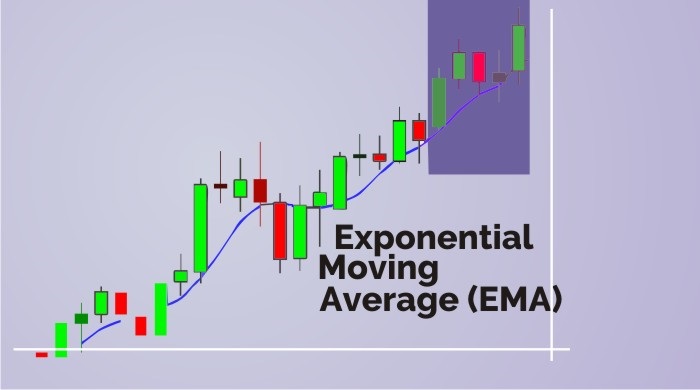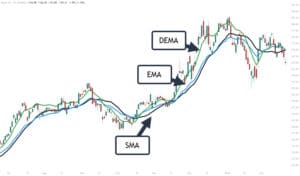An exponential moving average (EMA) is a type of moving average (MA) that places a greater weight and significance on the most recent data points.
First of all, spikes can impact the Simple moving averages. As we discussed in the previous lecture, Let’s begin with an example.
Let’s say we draw a 5-period SMA on the EUR/USD daily chart.
The following are the latest five days’ closing prices: On day 1, we got 1.3172. On the second day 1.3231, we got 1.3164 on the 3rd day, 1.3186 on the 4th day, and 1.3293 on the 5th day.
The simple moving average is as follows:
(1.3172 + 1.3231 + 1.3164 + 1.3186 + 1.3293) / 5 = 1.3209
Isn’t it simple enough?
What if, on Day 2, there’s a news piece that causes the euro to plummet across the board?
The EUR/USD fell to 1.3000 as a result of this. Let’s take a look at how this affects the 5-period SMA.
On day 1, we got 1.3172, on day 2 we got 1.3000. on the 3rd day, 1.3164, 1.3186 on the 4th day, and 1.3293 on the 5th day.
The simple moving average calculation is as follows:
(1.3172 + 1.3000 + 1.3164 + 1.3186 + 1.3293) / 5 = 1.3163
The outcome of the simple moving average would be much lower, giving the impression that the price was actually falling when, in reality, Day 2 was just weak economic data.
So, the point we’re attempting to make is that the basic moving average can be overly simplistic at times.
If only there was a method to filter these spikes out so you didn’t get the wrong impression.
Hmm… Just a moment… Yes, there is a solution!
This is the Exponential Moving Average.
The most recent periods are given more weight by exponential moving averages (EMA).
The EMA would give more weight to the prices of the most recent days in our example, which would be Days 3, 4, and 5.
This means that the Day 2 spike would be less significant and have less impact on the moving average than if we calculated for a simple moving average.
When you think about it, this makes a lot of sense because it focuses more on what traders have been doing recently.
Exponential Moving Average (EMA) vs. Simple Moving Average (SMA)
Let’s take a look at the USD/JPY 4-hour chart to see how a simple moving average (SMA) and an exponential moving average (EMA) compare on a chart.
Take note of how the red line (the 30 EMA). It appears to be more accurate pricing than the blue line (the 30 SMA).
As a result, it more precisely reflects the recent price movement. So, you presumably have a good idea why this occurs.
It’s because the exponential moving average throws a greater emphasis on recent events.
It’s considerably more crucial to look at what traders are doing RIGHT NOW. Compare it with how it looks at what they were doing last week or last month while trading.
Looking for a highly rated forex fund manager?
Fx Pips Guru has a strong group of forex experts who are managing forex accounts of our clients from different brokers dedicatedly. Just hire our forex fund managers here : https://www.fxpipsguru.com/forex-fund-manager/ .




